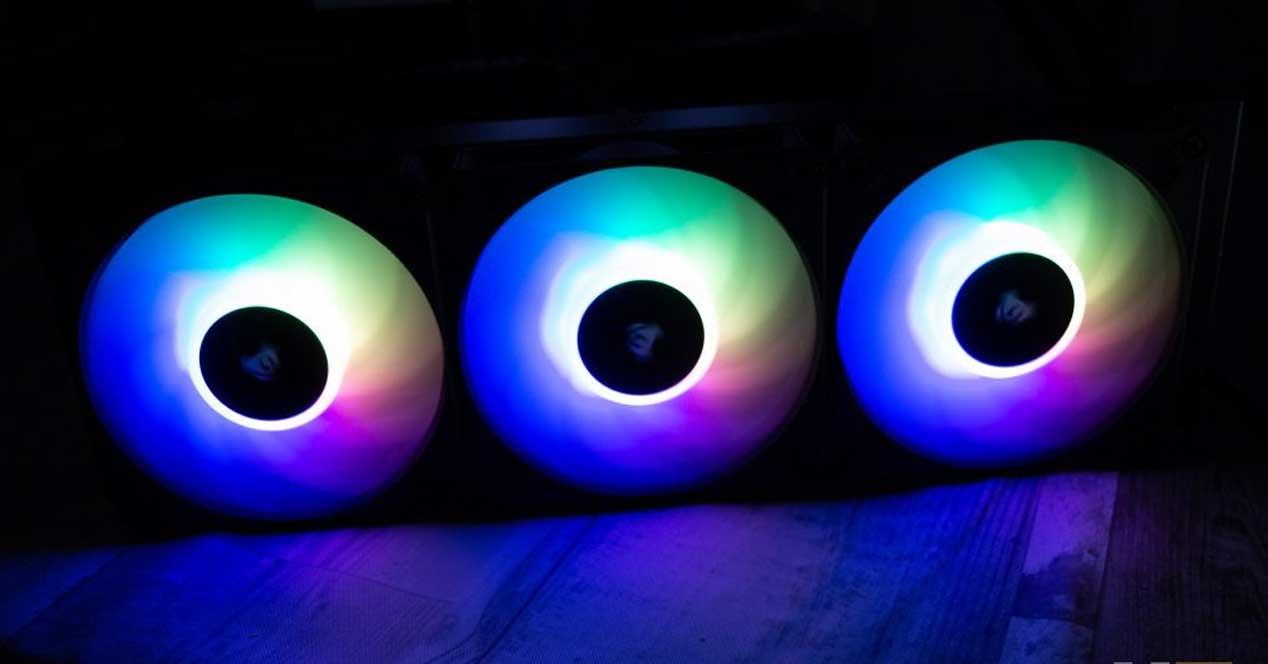Of course, we are dealing with fans with RGB, and in this case they incorporate 8 individually configurable RGB LEDs on each fan. To do this, CORSAIR markets them in packs of three fans that include a Lighting Node CORE, so that we can connect them to each other and configure them easily thanks to iCUE, the brand’s unified software.
Unboxing and external analysis
As we just mentioned, we are going to analyze a pack of three fans that include a Lighting Node CORE for the RGB connection of each of them, so they are packed in a box all together. As usual, on the front, the manufacturer shows us an image of the devices, accompanied by the brand, model and some of its features, such as the fact that the Lighting Node CORE is included.
On the back, and in several languages, CORSAIR gives us a description, accompanied by a table of specifications, an image of the Lighting Node CORE, and another of the fan on the back, with its AirGuide technology.
As usual, an instruction manual is not included, but when we open the box we find a QR code on one of the interior flaps that will take us to the manufacturer’s website.
In a small yellow box, CORSAIR has put all the accessories that are included. We have the safety booklets, warranty booklets, etc. usual, three bags of screws and the Lighting Node CORE.
The latter is used exclusively to control lighting, and supports up to 6 fans. We will need to connect it to both an internal USB header on the motherboard and a SATA power connector on the power supply.


Each of the three CORSAIR AF120 RGB ELITE fans is protected by a yellow cardboard box.
But let’s look at one of the fans individually first. The frame is square and black, while the blades are translucent to promote better distribution of light when lit. They have 9 fairly inclined blades to promote greater static pressure.
As already mentioned, each fan has two cables: the usual 4-pin PWM connector for power and a connector for RGB in which CORSAIR, with a nice yellow label, indicates that it must be connected to a RGB HUB.
The build quality of these fans is extremely good. Not only are they compact and robust, but they feature a multitude of details, such as the CORSAIR name on the top, or the model in the corners.


By the way, the corners are rubberized on both sides to absorb vibrations and reduce noise.
Finally, from the rear, we can see that the rotor is fixed to the frames by means of 9 inclined spokes, which constitute the air guide so that it comes out concentrated forwards and does not disperse.
After seeing the fans, it’s time to put them to the test. Here you can see how they are mounted in a CORSAIR 5000D Airflow case.


CORSAIR AF120 RGB ELITE review
As we have indicated before, to use the RGB lighting of these fans it is necessary to connect them to an RGB HUB, included in the case of this pack of three units. Once done, the iCUE software will detect them and allow us to configure how they work.
As you can see, iCUE detects the Lighting Node CORE. We proceed to configure it, and the first thing we encounter is that it was unable to detect how many or which fans it has connected.
So bottom left you have to tell them; In this case, you must select “Series of 8 LED fans” and you must tell it that there are 3 connected. Once done, the software will make them shine in a different color from each one so that we can physically identify them.
Now yes, in the Lighting Channel 1 section (there is no other, I don’t know why it is numbered) we can configure the colors and effects we want, both the predefined ones and those that we create ourselves. Each of the 8 individual LEDs on each fan is independently configurable.
In the Hardware Lighting section we have, as always, the configuration of how we want them to behave when iCUE is not active, such as when we turn on the PC.
Finally, in the Device Settings section, we can update the firmware and control the general brightness of all connected devices.
As always when we review a fan (or fans), we test it in the air to measure its performance without obstacles like grilles on the PC case or a heatsink (otherwise the comparison with other fans would have too many factors affecting fan performance), their performance and results would not be comparable).
We start with the volume and, as always, we used a Protmex PPM-SM001 sound level meter at a distance of exactly 50 cm from the fan, so the measured result is expressed in dBA. We made two measurements: one with the speed in PWM so that it works automatically, and another by configuring the fans at maximum speed. Here is the result :
We can see from the graph that these CORSAIR fans are not particularly quiet, although it is true that they have a particularly minimal noise when idle, since they do not even reach 17 dBA. However, at maximum speed they emit much more noise, although it is true that it is a natural noise of the air pushed by the blades, the noise of the rotor is not perceived, therefore they are not noisy and the sound is not annoying at all.
We are not dealing with the quietest fans on the market, but it must be borne in mind that this comparison is not fair in the sense that the AF120 RGB ELITE operate at 2,100 rpm at maximum speed, whereas other models in this comparison do it at a fairly slower pace.
Now let’s see how the performance is in terms of airflow, and to measure this we used a Holdpeak HP-866A anemometer, again performing two measurements: in the first, the fans are set to maximum speed, while that in the second we manually set them to spin at 1,000 rpm. This is the result.
In this case, we see that the CORSAIR AF120 RGB ELITE remains in the middle of the table, with performances that are not bad at all but that do not place them as the most powerful fans for PC either. It’s clear that the manufacturer wanted to strike a good balance between performance and noise, and we honestly think it has achieved this quite well.
However, there is another factor to take into account when evaluating the performance of certain fans and that is the static pressure, a data that unfortunately we cannot measure because we do not have the physical tools for it; we will trust the data that CORSAIR provides to us: up to 2.68mm/H2Owhich is great static pressure to push air through the aluminum sheets of heatsinks or radiators, or to channel air to all components if we install them as case fans.
Conclusion and judgment
They’re not the best-performing, nor the quietest, fans on the market; However, it is likely that the new CORSAIR AF120 RGB ELITE will be one of the fans with the best balance between performance and sound on the market today, in addition to incorporating an excellent RGB lighting system and with some configuration and customization possibilities beyond doubt.
Now… let’s take a look at the best PC fans you can buy? Probably not, but what is certain is that these fans are good in everything (especially in terms of static pressure, so if you are going to use them for a heatsink or a radiator, you will gain a lot in performance) and that, since, if you decide to buy them, you will not regret it.
For all these reasons, we think they deserve our gold medal, as well as our recommendation for their performance and design.


























